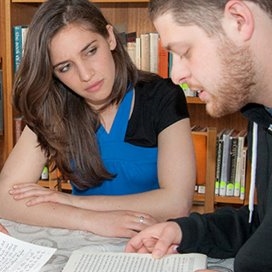
Religion

Taking Tikkun Leil into the modern world
ADINA ROTH
But first, what is tikkun? It has two possible meanings. The first and more well-known rendering is to fix something, while tikkun can also mean to adorn or beautify.
According to the Midrash, the Jewish people fell asleep at the giving of the Torah, kept G-d waiting on top of Mount Sinai and had to be woken to join the Revelation.
In deep remorse, we fix this faux pas and offence to G-d, by learning Torah all night on Shavuot for the rest of time. Some of the earliest sources that talk about Tikkun Leil are found in the Zohar, although this Kabbalistic work refers to it as an older practice.
For hundreds of years, the practice of Tikkun Leil was confined to religious men, studying Torah in the shul until dawn and Shacharit. However, Jewish learning today has become redefined, first by the 20th century phenomenon of Jewish women’s learning and also by a more recent embrace of Jewish learning by secular or unaffiliated Jews.
This latter trend was movingly articulated when Ruth Calderon, a secular Israeli woman from the Yesh Atid party, stood up, in 2013, in the Knesset and spoke about her love of ancient Jewish texts.
She spoke about the history of secular Zionism’s abdication of texts, in particular the oral tradition and she said: “The Torah is… a gift that every one of us received and we have all been granted the opportunity to meditate upon it as we create the realities of our lives.
“Nobody took the Talmud and rabbinic literature from us. We gave it away, with our own hands, when it seemed that another task was more important.”
Calderon has established Alma, the first secular yeshiva in Israel where people study Jewish texts and Talmud in particular, without any intention of assuming the strictures of Jewish practice.
Or consider Shulem Deen, a former Chassid in New York, who tells a powerful narrative of leaving the Chassidic world and Jewish observance completely, and then finding his way back into Judaism through studying the Talmud with a study partner in a disciplined weekly practice. Afterwards they would sometimes share a… wait for it… lobster and prosciutto dinner!
These trends point to a hybridisation of Judaism, reflecting the formation of the post-modern Jewish self. A secular person can enter passionately into the Jewish parts of herself without any intention of becoming “religious”, a Jewish atheist can study G-d as a concept, without an existential struggle about the tenets of Jewish faith.
This contrasts with the Judaism I grew up with, which is captured in the rabbinic dictum “to learn, in order to teach, in order to do”.
Yet, one can’t discard this renaissance as academic and detached, devoid of praxis. There is a strong ethical impetus behind a lot of this more secularised learning, even if the ethics does not translate to ritual mitzvot.
If Shavuot is the holiday that most celebrates the learning tradition of Judaism, it would make sense that Tikkun Leil Shavuot is reflective of these different learning iterations.
A case in point is Tikkun Leil in Tel Aviv. An article in Ha’aretz in 2012, describes how the secular hub of Israel has become one of the most exciting Tikkun Leil spots in the country as thousands of secular Israelis walk the streets attending learning events throughout the night.
The Israeli Bar Association, for example, hosts an event for Tikkun Leil, which discusses aspects of Israeli law. One can find learning across the city from classes on “free love” in a Reform synagogue, to Tibetan meditation sessions on the language of love.
Alma, Calderon’s secular yeshiva has set up its Tikkun Leil to the Tel Aviv museum, where people struggle to get into secular politician Yair Lapid’s class on Avraham: “How he was scared to be himself”.
The learning can also be found in trendy music and night clubs where a vigorous discussion on conversion takes place.
Tikkun Leil has moved from the traditional hub of men learning in their community with their rabbi, to become an on-trend nexus for the young, the old, the searching and the restless.
Lex Rufus, co-host of the edgy podcast Judaism Unbound, describes spending Tikkun Leil watching “bim-bam” videos for every Torah portion of the week. He observes that his Tikkun Leil practice was enabled using a medium that breaches traditional observances.
For Rufus, this kind of hybridisation of the ancient and the super-modern is to be celebrated.
Some may gasp at the flagrant breach of halachic standards reflected in these 21st century iterations of Tikkun Leil. It invites the question: What makes something authentically Jewish? If Jews of different persuasions are gathering and learning on Shavuot, in bars, in museums, with Tibetan teachings and with a cello in the background, where is the Judaism?
At what point does ritual lose its Jewish character and become another “Afrika-Burn”, a trendy experience for the experience-seeking human being of 21st century drama?
That said, I am reminded of a friend’s comment, that there are only two groups of Jews in the world today: engaged and disengaged Jews.
The story is not yet written as to what new embodiments of ancient practices will take hold and become incorporated, but I would argue, in a world of deepening disaffection and disaffiliation with Judaism, let’s suspend the judgement and celebrate every Jewish person’s desire to engage with Jewish text or Jewish ritual practice, even if accompanied by a ham sandwich.




